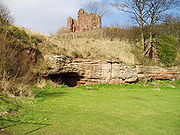
Macduff's Castle
Encyclopedia

East Wemyss
East Wemyss is a village situated on the south coast of the Kingdom of Fife, Scotland. In the United Kingdom Census 2001 the population was recorded as 1841.- History :...
, in Fife
Fife
Fife is a council area and former county of Scotland. It is situated between the Firth of Tay and the Firth of Forth, with inland boundaries to Perth and Kinross and Clackmannanshire...
, Scotland
Scotland
Scotland is a country that is part of the United Kingdom. Occupying the northern third of the island of Great Britain, it shares a border with England to the south and is bounded by the North Sea to the east, the Atlantic Ocean to the north and west, and the North Channel and Irish Sea to the...
. The site is associated with the MacDuff
Clan MacDuff
Clan MacDuff is a Scottish armigerous clan, which is registered with Lyon Court, though currently without a chief. Moncreiffe wrote that the Clan MacDuff was the premier clan among the Scottish Gaels. The early chiefs of Clan MacDuff were the Earls of Fife...
Earls of Fife
Earl of Fife
The Earl of Fife or Mormaer of Fife referred to the Gaelic comital lordship of Fife which existed in Scotland until the early 15th century....
, the most powerful family in Fife in the middle ages
Middle Ages
The Middle Ages is a periodization of European history from the 5th century to the 15th century. The Middle Ages follows the fall of the Western Roman Empire in 476 and precedes the Early Modern Era. It is the middle period of a three-period division of Western history: Classic, Medieval and Modern...
, although nothing survives from this period. The present ruins are the remains of the home of the Wemyss
Clan Wemyss
Clan Wemyss is a Lowland Scottish clan.-Origins of the Clan:The name "Wemyss" is derived from the Gaelic word ‘uaimh’, meaning ‘cave’, and is believed to be taken from the caves and cliffs of the Firth of Forth in that part of Fife where the family of Wemyss made its home. Wemyss in Fife has been...
family, who lived here from the 14th century, and their successors in the 16th century.
History
It is thought that a castle may have been built here by the MacDuff MormaerMormaer
The title of Mormaer designates a regional or provincial ruler in the medieval Kingdom of the Scots. In theory, although not always in practice, a Mormaer was second only to the King of Scots, and the senior of a toisech.-Origin:...
s, or Earls, of Fife in the 11th century, at the time of King Macbeth of Scotland
Macbeth of Scotland
Mac Bethad mac Findlaích was King of the Scots from 1040 until his death...
(d.1057). The Wemyss family, descendents of the MacDuffs, owned the property from the 14th century, and built the earliest part of the present castle. Edward I of England
Edward I of England
Edward I , also known as Edward Longshanks and the Hammer of the Scots, was King of England from 1272 to 1307. The first son of Henry III, Edward was involved early in the political intrigues of his father's reign, which included an outright rebellion by the English barons...
paid a visit here in 1304, staying with Sir Michael Wemyss. However, Wemyss later joined forces with Robert the Bruce, and Edward ordered the castle to be destroyed.
After the Wemyss family moved to nearby Wemyss Castle
Wemyss Castle
Wemyss Castle is situated on the cliffs between the villages of East Wemyss and West Wemyss in Fife, Scotland.- History :Accounts date the construction of the castle to the year 1421 when Sir John Wemyss decided to build a fortified castle to replace one destroyed by the Duke of Rothesay at...
, it passed to the Livingstones, and then in 1530 it was taken over by the Colvilles who built a second tower to the south-west, and enclosed a courtyard with a gatehouse. In 1637 the castle was bought by Sir John Wemyss of West Wemyss
West Wemyss
West Wemyss is a village lying on the north shore of the Firth of Forth, in Fife, Scotland. According to the 2007 population estimate, the village has a population of 237. The village was granted burgh of barony status in 1511, bearing the name from the Wemyss family who lived in Wemyss Castle...
, from Lord Colville of Culross
Culross
The town of Culross, pronounced "Coo-ros", is a former royal burgh in Fife, Scotland.According to the 2006 estimate, the village has a population of 395...
, and in 1651 the lands of East and West Wemyss were united as a single barony.
Description
The ruins comprise the remains of a four storey 14th century tower, and a five-storey 16th century tower. The two are connected by 16th century gatehouse range, with 17th century walls containing gun loopsEmbrasure
In military architecture, an embrasure is the opening in a crenellation or battlement between the two raised solid portions or merlons, sometimes called a crenel or crenelle...
. The castle is supposedly haunted by a "Grey Lady", said to be a Mary Sibbald who was found guilty of theft and died in the castle. The castle is a Scheduled Ancient Monument
Scheduled Ancient Monument
In the United Kingdom, a scheduled monument is a 'nationally important' archaeological site or historic building, given protection against unauthorized change. The various pieces of legislation used for legally protecting heritage assets from damage and destruction are grouped under the term...
and a Category B listed building. A 16th century dovecote
Dovecote
A dovecote or dovecot is a structure intended to house pigeons or doves. Dovecotes may be square or circular free-standing structures or built into the end of a house or barn. They generally contain pigeonholes for the birds to nest. Pigeons and doves were an important food source historically in...
stands to the south of the castle. The castle remains the property of the Wemyss Estate.

